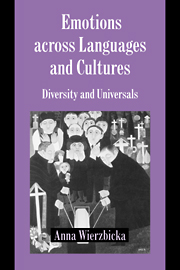Book contents
- Frontmatter
- Contents
- List of figures
- Acknowledgments
- List of abbreviations
- 1 Introduction: feelings, languages, and cultures
- 2 Defining emotion concepts: discovering “cognitive scenarios”
- 3 A case study of emotion in culture: German Angst
- 4 Reading human faces
- 5 Russian emotional expression
- 6 Comparing emotional norms across languages and cultures: Polish vs. Anglo-American
- 7 Emotional universals
- Notes
- References
- Index
2 - Defining emotion concepts: discovering “cognitive scenarios”
Published online by Cambridge University Press: 22 August 2009
- Frontmatter
- Contents
- List of figures
- Acknowledgments
- List of abbreviations
- 1 Introduction: feelings, languages, and cultures
- 2 Defining emotion concepts: discovering “cognitive scenarios”
- 3 A case study of emotion in culture: German Angst
- 4 Reading human faces
- 5 Russian emotional expression
- 6 Comparing emotional norms across languages and cultures: Polish vs. Anglo-American
- 7 Emotional universals
- Notes
- References
- Index
Summary
Introduction
Ten years ago Ortony, Clore, and Collins (1988: 12) argued that “an analysis of emotion must go beyond differentiating positive from negative emotions to give a systematic account of the qualitative differences among individual emotions such as fear, envy, anger, pride, relief, and admiration”. While a great deal of work has been done during the intervening decade I believe no such systematic account has as yet emerged.
This chapter makes an attempt at such a systematic account, anchored in an independently established and justified set of universal semantic primes. While no exhaustive discussion of all the emotion concepts encoded in the English lexicon has been attempted, the account given here does include detailed analysis of some fifty emotion concepts such as fear, pride, relief, and admiration, which constitute the core of the English emotion lexicon. Most of the emotion concepts which have been written about in the extensive cross-disciplinary literature on “emotions” have in fact been covered here, and while it was impossible to discuss the literature on individual “emotions” fully, all sections of this chapter include some critical discussion of their earlier treatment – by psychologists, philosophers, anthropologists, sociologists, and historians.
Like any other set of complex entities, emotion concepts can be classified in many different ways.
- Type
- Chapter
- Information
- Emotions across Languages and CulturesDiversity and Universals, pp. 49 - 122Publisher: Cambridge University PressPrint publication year: 1999
- 1
- Cited by



